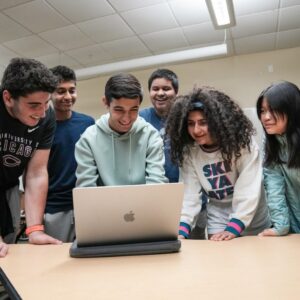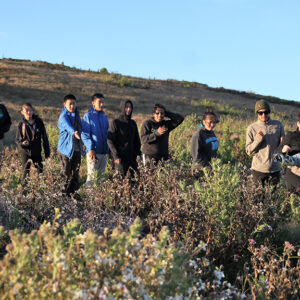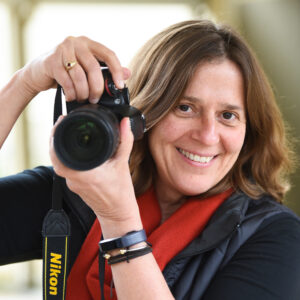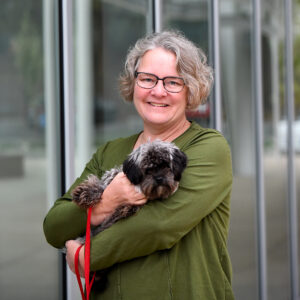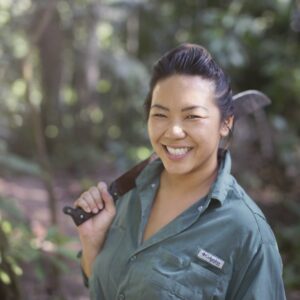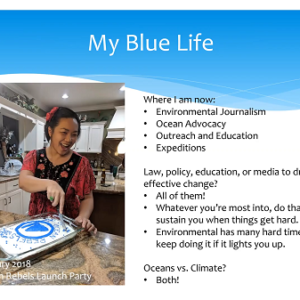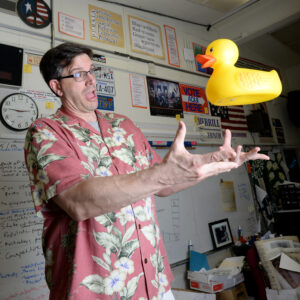This story originally appeared in the fall/winter 2017 issue of Harker Magazine.
Haris Hosseini, grade 11, knew Alaska was a photographer’s dream long before he arrived in Juneau, but seeing the stunning landscapes and incredible wildlife up close made him realize at a more visceral level how amazing it is. “I’ll always remember being on the top floor of a boat, staring at a hulking glacier with chunks of ice falling right in front of me,” he said. “I know that environmental activism will play a role in my life, no matter what career I choose.”
At Harker, developing students into global citizens is a goal that is brought to life through more than a dozen school-sponsored trips, starting in fourth grade. Carefully curated activities, genuine interactions with student host “buddies” and deep reflection help students become confident and curious travelers.
Grade 4 and 5 students travel for a few days and middle schoolers travel for a week on all-class trips. Middle and upper school students also have a number of student exchanges and school-sponsored summer trips from which to choose, while performing arts, speech and debate, and other academic departments lead excursions to far-flung locations including London, Nigeria, Costa Rica, Switzerland, China and Japan. “Our programs grow with the students,” explained Jennifer Walrod, director of global education, noting such trips prepare students to succeed in college and beyond. In fact, the school’s mission statement contains those very words – “success at college and beyond” – and that sentiment, along with the pledge to “embrace diversity … preparing students to take their place as global citizens” are never far from the mind of those who support these excursions.
The joy of travel for students goes beyond exploring a new place or a different culture, explained Jennifer Gargano, assistant head of school for academic affairs. It also helps them develop skills that they will carry with them for a lifetime, like resilience and cultural sensitivity. “You can see students coming back from these trips feeling so empowered as individuals,” she said. “They realize that they are capable of so much more than they knew.”
Getting Started: Coloma and the Marin Headlands
Harker students begin their travels in fourth grade with an all-class trip to Coloma, followed in grade 5 by a trip to the Marin Headlands.
Harker’s fourth grade students spend two nights and three days living like gold miners at the Coloma Outdoor Discovery School, a few hours northeast of San Jose, where they learn to pan for gold and build a lean-to, as well as attend a hoedown with a live string band. But the highlight for many is a different activity, says Kristin Giammona, elementary division head. “One night, students make cornbread over the fire, and it’s a big deal,” she said. “Many of them have never really cooked before, but the cornbread is something they make with their own hands, cook over a fire and eat while it’s still warm.” Later, they learn to do dishes – complete with checkered aprons – and delight in the opportunity to work together to clean up with their friends.
Students learn history through a presentation from a Native American storyteller and environmental studies during hikes. They also learn to take real responsibility for themselves. They make their beds, pack up their suitcases and learn to go to sleep at “lights out.”
In fifth grade, the big trip is to the Marin Headlands in Sausalito, where students visit the Marine Mammal Center and the ocean, and do miles of hiking. Students stay in old army barracks. Giammona said she delights in seeing the growth in students in just one year. “The anxiety almost disappears, because kids have already [gone on a school trip] once before,” she says. “I can see the confidence and independence grow.”
Seasoned Travelers on Grand Adventures
Each fall, Harker sixth graders take a multiday trip to explore California. Through the years, sixth graders have learned about the great outdoors by hiking, kayaking and studying nature with their teachers in places including Mount Cross in the Santa Cruz Mountains and Yosemite National Park. Then in grade 7, students fly to Arizona, from which they set out to explore several national parks.
Long before she boarded the plane for Harker’s annual grade 7 national parks trip, Yejin Song, now grade 8, said she had been dreaming about it. “I remember counting off the days until the trip multiple weeks in advance,” she said. “School trips are one of the main highlights of my year.”
The trip didn’t disappoint. From the Grand Canyon to Bryce Canyon to Zion, Song says she was awestruck by the scenery of the national parks. “There was always a beautiful view at the end of every hike that made the effort and the sweat worth it,” she said.
Indeed, the trip is carefully structured to inspire exactly that sense of wonder, said Alana Butler, trip leader and middle school dean of students. For their Grand Canyon experience, for example, trip leaders blindfolded kids for a short hike; students held on to a guide rope as they carefully made their way to a lookout point and counted to three before removing their blindfolds. “They see the Grand Canyon for the first time, and you get all sorts of ‘oohs’ and ‘ahs’ and ‘whoas,’” Butler said. It’s an immersive experience that no postcard or video can match, and just one of countless memorable moments on the six-day trip.
The 150 or so students on the trip also visit a family ranch, where they learn about traditional Navajo customs, including weaving and cooking fry bread. In Bryce Canyon, they peer at the stars through telescopes while a ranger leads an astronomy lesson. And throughout the week, they get lessons in ecology, wildlife and geology.
One of the best parts, said Song, was that students spent time getting to know one another. “I spent time not only with my close friends, but also with another student who I ended up bonding with throughout the trip,” she said.
Students also learned to follow key rules to stay safe and travel efficiently as a group, learning to handle curfews, call times and bathroom breaks, among other things.
“It was great to enjoy and revel in the beauty of the places we visited,” said Song. “Taking pictures is helpful to keep memories, but I always tried to remember to take a moment to put my phone down to really experience and appreciate it.”
The Big One
In grade 8, students travel to the land of our county’s birth, visiting Jamestown, Colonial Williamsburg and Civil War battlefields in Virginia and surrounding areas. They then head to Washington, D.C., where they visit the U.S. Capitol and Supreme Court. The group also learns about the more somber side of our country’s history, visiting the Martin Luther King Jr. Memorial, the Lincoln Memorial, the Korean War Veterans Memorial, the Vietnam Veterans Memorial Wall, the Iwo Jima U.S. Marine Corps War Memorial and Arlington National Cemetery.
Middle School Options
As one of the several exchanges available to Harker students, about two dozen middle school students each year head to Tokyo to learn alongside students at Tamagawa Academy, with whom they have nurtured relationships since kindergarten through letters and video conferences. Harker has had a relationship with the Tamagawa Academy since 1993, making it the longest-lasting international program in Harker’s history. A group of students also travels to Shanghai, where they visit students from their sister school, the World Foreign Language Middle School. Each year, a group of middle schoolers travels to Costa Rica to visit with sister school students and immerse themselves in the Spanish language. In spring 2018, seventh and eighth grade students have the opportunity to visit Greece to learn more about Greek history and archaeology. Finally, there is a middle school backpacking trip where students explore California’s hinterland.
Upper School Options
Upper school students have a range of opportunities to pursue specific interests in unique locations. Students take an annual trip to the Oregon Shakespeare Festival in Ashland and, every four years, Harker Conservatory students have performed at the Edinburgh Festival Fringe in Scotland. The orchestra traveled to London for the New Year’s Day Parade in 2012 and, last spring, to New York to perform at Carnegie Hall. In 2012, the Harker Conservatory’s women’s classical ensemble, Cantilena, toured Italy and sang at the Academy of Music in Florence.
Other trips come up as teachers and students find subjects they want to further explore. For example, this past summer, Hosseini traveled to locations near and far for 23 days as one of 10 students enrolled in a special summer-only course, Human Ecology, led by upper school science teachers Chris Spenner and Kate Schafer. The question that drove the class was deceptively simple: How do humans connect with nature?
For weeks, the group studied the issue through a range of local lenses, researching everything from agriculture to fisheries to energy. The class visited the Bodega Marine Laboratory in Sonoma County, and also learned about organic agriculture management practices at farms just 20 miles outside of San Jose.
The class concluded with a transformative 10-day trip to Alaska, where the students looked at how the issues they studied in Northern California play out nearly 3,000 miles north. The contrasts were both striking and valuable, said Spenner. “The class allowed them to see not only what was going on in their immediate area, but to have a dramatic comparison point with things in Alaska,” he said. The class visited hydropower plants in Juneau and the small community of Gustavus. They met with local commercial fishermen and went on hikes while discussing climate change. They also got to appreciate Alaska in what some might say is its purest form: They spent four days tent camping on the Inian Islands and spoke with an indigenous elder from the Tlingit tribe.
While on the islands, students collected materials and ideas that they developed into projects shared at an evening showcase upon their return. Alex Shing, grade 10, for example, focused on Tlingit mythology, writing a story based on the tales he heard on the trip. “Before this trip, I had never taken a class that let me focus on what I was specifically interested in,” he said. “That enticed me.” Hosseini, meanwhile, teamed up with Haley Keller, grade 12, to photograph and interview more than 60 people they encountered during the trip. “We created a ‘Humans of New York ’-style book of photographs and interview snippets,” he said. “It helps us remember the stories we’d otherwise forget.” Students were required to spend time journaling about their activities and reflecting on the lessons of each day, which Spenner said often shifted students’ priorities in meaningful ways. “By the end of it, students were saying things like ‘I need to make small changes in my life, like biking more and driving less. I need to think about taking classes that I’m really interested in, not just ones that contribute to a good GPA, because it’s experiences like these that I’ll actually remember forever,’” he said. “It really opened their minds.”
Overseas Experiences
Harker has had an exchange with the Collège de Gambach, a secondary school in Switzerland near an important economic and cultural border, since 2005. Swiss students spend 10 days with Harker students in San Jose in the spring, then Harker students visit Switzerland in summer. As part of the Swiss exchange trip last June, Joanna Lin, grade 12, sampled treats from the Cailler chocolate factory, toured the capital city of Bern and saw the Large Hadron Collider, a powerful particle accelerator. But her favorite part of the 10-day stay happened the night she arrived and met her exchange “buddy,” 18-year-old Marie Galley.
“We drove up to a solitary farm in the mountains for a birthday party,” recalled Lin, “and I learned it was built in the 16th century. It had a field of cows just beyond the backyard, where there was a barbecue.” As she chatted with the Swiss teenagers there, she couldn’t help but notice the contrasts between her own hard-charging and future-focused mentality – “a Silicon Valley mindset” – and that of her Swiss counterparts, who went out to enjoy relaxed time with friends most nights.
During her stay, Lin challenged herself to speak only French, to talk to other international students at the school she attended and to learn Kin-Ball, a game that uses a ball that’s four feet in diameter. You wouldn’t see these ground-level activities on a typical tour of Switzerland – and that’s exactly the point, said Galina Tchourilova, trip leader and French teacher. “It’s not a tourist trip,” she said. “It’s a deeper experience.” For example,students are strongly encouraged to try the local dishes and to fully embed themselves with the families that host them during their stay, she noted.
Tiny moments made big impressions. Aryana Far, grade 11, recalled visiting an open-air fruit stand that didn’t have a vendor present, just a box to insert the money. “My host mom picked a few tomatoes and lettuce and slid the money into the box,” Far recalled with astonishment. “She said this was common, and explained that Swiss culture strives to manifest a level of universally understood trust.”
For Kismet Singh, grade 10, even the simplest experiences were joyful. “One of the most fun things I did with my buddy was go paddle boarding on a lake,” she said. “I loved hanging out and getting close with my buddy.” For many students, the two trips are the beginning of what they hope will be a lifelong connection. “Many of them consider [their exchange buddies] friends, and they’ve made plans for them to come back to the United States so they can do more together,” said Tchourilova. Mallory Millard, grade 12, went on all the lower and middle school trips, except the grade 7 trip to the Grand Canyon. This summer, she was among the group that traveled to Alaska.
“I definitely do feel more comfortable with being away from home after my experiences on Harker trips,” she said. “The independence that the trips gave me was not only refreshing, but vital in order to make me more comfortable with living without the presence of my parents. From all of these trips, I have gained unforgettable memories, learned more than I could have imagined and cultivated the motivation to step out of my comfort zone.”



